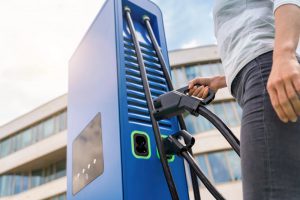 Electric vehicles are no longer a trend—they’re the future of transportation. By 2030, California’s ambitious clean-energy mandates will require that 100% of new light-duty vehicles sold be zero-emission, and commercial properties are expected to play a central role in supporting this transition.
Electric vehicles are no longer a trend—they’re the future of transportation. By 2030, California’s ambitious clean-energy mandates will require that 100% of new light-duty vehicles sold be zero-emission, and commercial properties are expected to play a central role in supporting this transition.
For businesses, that means one thing: the opportunity to future-proof your property with solar-powered EV charging infrastructure.
At Energy Independence Professionals (EIP), we specialize in helping California companies integrate solar and EV charging to reduce energy costs, attract customers, and capitalize on 2025’s limited-time tax incentives before they phase out. Here’s how pairing solar and charging stations can turn your facility into a next-generation energy hub.
1. Why Commercial Properties Need Solar + EV Charging Now
California leads the nation in both EV adoption and solar generation, making it the ideal environment for combining the two. Commercial buildings—auto dealerships, retail centers, golf courses, office parks, and logistics hubs—are uniquely positioned to benefit from solar-powered EV infrastructure.
Key reasons to invest today:
- Cut operating costs by generating and using your own clean power.
- Protect against rising utility rates and grid demand charges.
- Meet state and local sustainability requirements for new developments.
- Attract EV-driving customers and employees with on-site charging.
- Take advantage of 2025 federal tax credits and depreciation before deadlines expire.
Simply put, a solar-integrated charging system isn’t just a sustainability upgrade—it’s a long-term financial strategy.
2. How Solar Powers EV Charging Stations
The concept is simple but powerful: solar panels generate electricity during the day, which can directly charge electric vehicles or feed stored energy into onsite batteries. This local generation reduces strain on the utility grid and allows property owners to control when and how electricity is used.
Typical system components include:
- Rooftop or carport solar panels
- EV charging stations (Level 2 or DC Fast)
- Battery storage for load balancing and backup power
- Smart inverters and monitoring software
The result is an energy ecosystem that’s cleaner, more resilient, and significantly cheaper to operate.
3. Financial Incentives and Tax Benefits in 2025
Combining solar and EV charging gives commercial property owners access to an unprecedented mix of federal and state financial programs—but timing is everything.
Federal Incentives
- 30% Investment Tax Credit (ITC): Available for solar and energy-storage systems installed and placed in service before December 31, 2025.
- EV Charger Credit (Alternative Fuel Infrastructure Tax Credit): Covers up to 30% of the cost of commercial EV charging equipment (capped at $100,000 per unit).
- Accelerated Depreciation (MACRS): Allows businesses to deduct most of the system’s cost within five years, generating thousands in additional tax savings.
- Bonus Depreciation: 60% for 2025, enabling even larger first-year deductions.
California State Incentives
- Self-Generation Incentive Program (SGIP): Rebates up to $1,000 per kWh for commercial battery installations.
- California Electric Vehicle Infrastructure Project (CALEVIP): Offers rebates of $30,000–$80,000 per charger, depending on location and charger type.
- Property-Tax Exclusion: Solar and storage systems are excluded from property-value reassessments through 2027.
- Utility Rebates: SDG&E, PG&E, and SCE provide additional EV-infrastructure grants and make-ready funding.
EIP’s financial modeling process ensures our clients capture every available credit, rebate, and depreciation opportunity—reducing net project costs by up to 60%.
4. Real-World ROI Example: Solar + EV Carports for a California Dealership
Let’s look at a simplified example to show how these benefits stack up.
| System Size | 180 kW solar + 8 EV chargers |
| Total Project Cost | $650,000 |
| Federal ITC (30%) | −$195,000 |
| EV Infrastructure Credit | −$80,000 |
| MACRS Depreciation Tax Savings | −$120,000 |
| SGIP Battery Rebate | −$45,000 |
| Net Effective Cost | $210,000 |
| Annual Utility & Fuel Savings | $70,000+ |
| Payback Period | ≈ 3 years |
| 25-Year Lifetime Savings | $1.3 million+ |
Beyond the financial return, the dealership gains shaded customer parking, zero-emission branding, and the ability to power future EV sales without grid dependence.
5. Designing Smart Energy Ecosystems for Commercial Sites
EIP designs solar + EV charging systems around your facility’s existing power profile and long-term growth. A properly engineered system can handle daily operations and EV demand while maintaining grid stability.
Key design strategies:
- Rooftop + Carport Integration: Rooftop arrays offset building loads while solar carports supply shaded, convenient charging.
- Battery Storage Integration: Captures midday overproduction and dispatches power during evening peaks, lowering demand charges.
- Load-management software: Automatically adjusts charging rates to align with solar output and time-of-use pricing.
- Scalability: Infrastructure can be expanded as EV adoption grows, ensuring your property remains future-ready.
EIP’s consulting-first approach ensures every project is optimized for both performance and return on investment—from engineering through permitting, construction, and long-term monitoring.
6. Future-Proofing for Regulations and Market Demand
California’s regulatory landscape is shifting fast.
- By 2035, the state aims for a zero-emission vehicle mandate across nearly all new passenger and medium-duty vehicles.
- Commercial buildings are increasingly required to include EV-ready parking spaces under Title 24 building codes.
- Major fleet operators, cities, and universities are electrifying rapidly—and they need reliable charging infrastructure.
Installing solar-powered charging today positions your property as a compliance-ready asset—and a magnet for tenants, customers, and employees who value sustainability.
7. Why Partner with Energy Independence Professionals
While most solar companies focus on installations, EIP Consulting provides something more: a comprehensive energy-investment strategy.
We combine engineering expertise, financial modeling, and hands-on project management to deliver turnkey commercial solar and EV-charging systems across California.
Our process includes:
- Feasibility & site evaluation
- Custom solar + charger system design
- Incentive and tax-credit analysis
- Competitive contractor bidding and oversight
- Permitting, coordination, and commissioning
- Performance monitoring and maintenance
With EIP, you’re not just installing equipment—you’re building an asset that generates measurable returns and long-term resilience.
8. The Bottom Line
The race toward electrification is accelerating—and commercial properties that act now will capture the greatest financial and strategic advantages.
By integrating solar power and EV charging infrastructure, California businesses can:
- Lower operating costs
- Earn substantial federal and state incentives
- Increase property value
- Enhance brand reputation
- Prepare for an all-electric future
The opportunity window is closing.
Federal tax credits begin phasing down after 2025, and incentive programs are expected to tighten as demand rises.
Don’t wait for the future—build it into your property today.
Start Your Solar + EV Charging Consultation
Energy Independence Professionals (EIP) helps commercial property owners design and deploy solar-powered EV charging systems that maximize incentives, savings, and long-term ROI.
Call (619) 629-6556 or visit energyindependenceprofessionals.com to schedule your Free Solar Incentive Review today.
